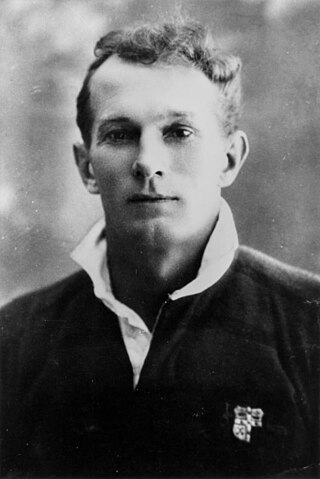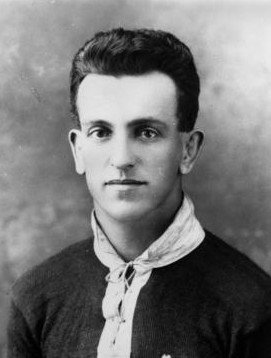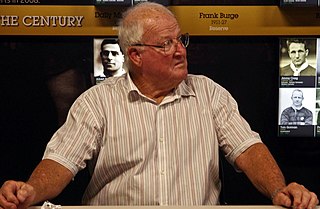Related Research Articles

Jason Smith is an Australian former professional rugby league footballer who played in the 1990s and 2000s. A Queensland State of Origin and Australian international representative five-eighth or lock forward, he played club football in Australia for the Canterbury-Bankstown Bulldogs, Parramatta Eels, Canberra Raiders and the North Queensland Cowboys, and in England for Hull F.C.. At his peak he was regarded as one of the game's greatest players.
Stephen John Ella is an Australian former rugby league footballer who played in the 1970s and 1980s. He was a utility back for the Parramatta Eels, New South Wales and Australia, playing in 4 Tests for Australia between 1983 and 1985. He is a cousin of the Ella brothers who were prominent in Australian rugby union in the 1980s.

Victor John Hey, also known by the nickname of "The Human Bullet", was an Australian rugby league national and state representative five-eighth and later a successful first-grade and national coach. His Australian club playing career commenced with the Western Suburbs Magpies, and concluded with the Parramatta Eels. In between he played for a number of clubs in the English first division. He is considered one of Australia's finest footballers of the 20th century
Norman Douglas Somerville Provan was an Australian professional rugby league footballer and coach. Also nicknamed "Sticks", he was a second-row forward with the St. George Dragons during the first ten of their eleven consecutive premiership-winning years (1956-1966). Named among the nation's finest footballers of the 20th century, he was a representative in the Australia national team from 1954 to 1960, winning 14 Tests and two World Cups. In 2018, he was inducted as the 13th Immortal of Australian rugby league.
Elton Rasmussen (1936–1978) was an Australian professional rugby league footballer who played in the 1950s and 1960s. He was a second-row with the St. George Dragons during the second half of their 11-year consecutive premiership winning run from 1956 to 1966. He was a representative in the Australian national team from 1959 to 1962 and from 1967 to 1968.

Arthur James Summons was an Australian representative rugby union and rugby league player, a dual-code rugby international fly-half or five-eighth. He captained the Australian national rugby league team in five undefeated test matches from 1962 until 1964 and later also coached the side.

Christopher Hobart McKivat was an Australian rugby union and rugby league player – a dual-code rugby international. He represented the Wallabies in over 20 Tests and tour matches from 1907 to 1909 and the Kangaroos in 5 Tests from 1910 to 1912. He is unique in Australian rugby history as the only man to captain both the national rugby union and rugby league teams. Following his playing career, he became the most successful coach of North Sydney in the club's history.
Greg Veivers is an Australian former rugby league footballer who captained Australia in a Rugby League World Cup match in 1977. He represented Australia in seven World Cup matches from 1975 and 1977. He was a front-rower and a regular Queensland state representative from 1970 to 1978.

Herbert Walt Steinohrt was an Australian rugby league footballer who played in the 1920s and 1930s as a front row forward for the Australian national team. He played in 9 Tests between 1928 and 1932 as captain on 3 occasions. He has been widely regarded as one of the greatest forwards in rugby league history, being named in the "Queensland Rugby League's Team of the Century", Australian rugby league's 100 greatest players and Toowoomba and South West Team of the Century. Steinohrt was terrific on and off the field, he never lost his temper and was a smart tactician who never played the same game twice. The Valleys Roosters in the Toowoomba Rugby League Competition home ground is named Herb Stenohrt Oval in his honour.

Brian Patrick Carlson was an Australian professional rugby league footballer who played in the 1950s and 1960s. He was a centre & utility back for the Australia national team. He played in 17 Tests and 6 World Cup games between 1952 and 1961, as captain on 2 occasions. He is considered one of the nation's finest footballers of the 20th century.

John Thomas Gorman was an Australian rugby league footballer. He was a centre for the Australian national team. He played in 10 Tests between 1924 and 1930 as captain on 7 occasions.

Peter "Mick" Madsen was an Australian rugby league footballer. He was a front-row forward for the Australian national team. He played in nine Tests between 1929 and 1936 as captain on one occasion and has since been named as one of the nation's finest footballers of the 20th century. He was known as a player who possessed freak strength and courage.

Duncan Fulton Thompson MBE was an Australian veteran of both WWI and WWII and a rugby league footballer, coach and administrator. He was wounded on active service in WWI and has been named amongst the nation's finest footballers of the 20th century, and is regarded as the father of modern coaching. He was appointed a Member of the Order of the British Empire (MBE) in the 1960 New Year Honours "for services to the community in the field of Sport."

Noel Raymond Kelly was an Australian professional rugby league footballer and coach, who played at club, state and national levels. He was named among the country's finest footballers of the 20th century. Kelly played as a hooker, prop forward or lock for much of his top-grade career with the Western Suburbs Magpies, whom he played for in three consecutive NSWRFL grand finals from 1961 to 1963. Kelly was named at hooker of the Western Suburbs Magpies, Queensland and Australian teams of the 20th century.
Albert Bentley "Son" Burge was an Australian rugby union lock who played with the Souths rugby union club in Sydney and at the age of nineteen was selected for the Australian national team in two Tests against New Zealand in 1907.

Jim Bennett was an Australian rugby league footballer who played in the 1910s, 1920s and 1930s who played for the Australian national team. A Queensland state representative front-row forward, he played his entire career for clubs in Queensland, and was one of the state's early star players, making thirty-six appearances for the Maroons between 1921 and 1930.
The 1988 Great Britain Lions tour was the Great Britain national rugby league team's 18th tour of Australasia and took place from May to July 1988. It started with a Test match against Papua New Guinea before the best-of-three series against Australia for the Ashes title, and finally a Test against New Zealand. Some of these matches counted toward the ongoing 1985–1988 World Cup tournament. An additional 13 matches were played against local club and representative sides from each host nation.
The 1920 Great Britain Lions tour was the third British national rugby league team or 'Lions' tour of Australasia, where it was winter and matches were played against the Australian and New Zealand national sides, as well as several local teams. In Australia, the three-Test match series was won by the hosts. In New Zealand another three-Test series was played and won by the visitors. The tour was a success and brought in a handsome profit.
The 1946 Great Britain Lions tour was a tour by the Great Britain national rugby league team of Australia and New Zealand which took place between April and August 1946. The tour involved a schedule of 27 games: 20 in Australia including a three-test series against Australia for the Ashes, and a further 7 in New Zealand including one test match against New Zealand.
The 1954 Great Britain Lions tour was a tour by the Great Britain national rugby league team of Australia and New Zealand which took place between May and August 1954. Captained by Dickie Williams, the tour involved a schedule of 32 games: 22 in Australia and 10 in New Zealand, with two three-match Test Series against both nations.
The tour began inauspiciously, with Great Britain losing four of their first seven matches, including the First Test against Australia in Sydney. Moving into the Queensland leg, the Lions' results improved, and they won all nine of their matches in the state. This included victory in the Second Test in Brisbane.
A common feature of many of the tour matches was rough play, punches being throw in and out of tackles. The July 10 match against New South Wales was abandoned by the referee seventeen minutes into the second half due to persistent brawling by the players.
One week after the abandoned game, Australia won the Third Test to claim the Ashes by a 2–1 margin.
Moving to New Zealand, Great Britain lost the Second Test, but recovered to win the Third Test and the series, by a 2–1 margin.
The tour concluded with three matches in five days back in Australia at Sydney, Canberra and Maitland.
Despite being a British team – five of the squad were Welsh, two from Scotland and hooker Tom McKinney from Northern Ireland – the team played, and were often referred to by both the press at home and away, as England.
References
- 1 2 "Spanish Zest In Aust. Test Side". The Sydney Morning Herald. 27 June 1962.
- ↑ "Q'land Centre Ill, Doubt For R.L." The Sydney Morning Herald . 27 August 1963.
- ↑ "Rugby historian's home-grown heroes". The North West Star. 1 December 2014.
- ↑ "Soft Test Ground Will Suit England". The Sydney Morning Herald. 14 July 1962.